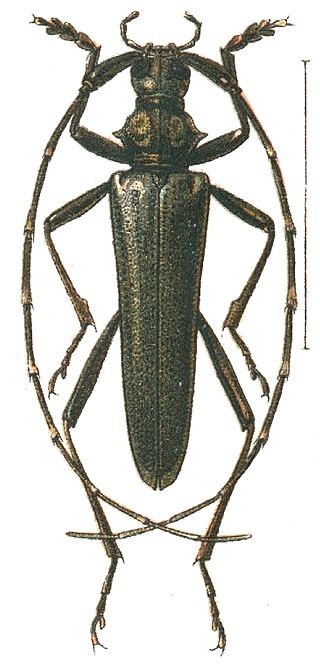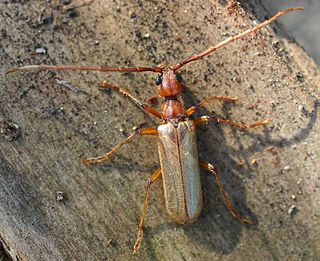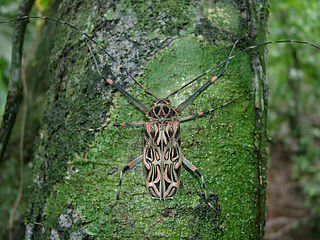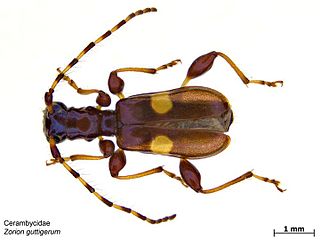
Prosopis is a genus of flowering plants in the family Fabaceae. It contains around 45 species of spiny trees and shrubs found in subtropical and tropical regions of the Americas, Africa, Western Asia, and South Asia. They often thrive in arid soil and are resistant to drought, on occasion developing extremely deep root systems. Their wood is usually hard, dense and durable. Their fruits are pods and may contain large amounts of sugar. The generic name means "burdock" in late Latin and originated in the Greek language.

The longhorn beetles (Cerambycidae), also known as long-horned or longicorns, are a large family of beetles, with over 35,000 species described. Most species are characterized by extremely long antennae, which are often as long as or longer than the beetle's body. In various members of the family, however, the antennae are quite short and such species can be difficult to distinguish from related beetle families such as the Chrysomelidae. The scientific name of this beetle family goes back to a figure from Greek mythology: after an argument with nymphs, the shepherd Cerambus was transformed into a large beetle with horns.

Schinus is a genus of flowering trees and tall shrubs in the sumac family, Anacardiaceae. Members of the genus are commonly known as pepper trees. The Peruvian pepper tree is the source of the spice known as pink peppercorn.

Acacia, commonly known as the wattles or acacias, is a large genus of shrubs and trees in the subfamily Mimosoideae of the pea family Fabaceae. Initially, it comprised a group of plant species native to Africa and Australasia. The genus name is Neo-Latin, borrowed from the Greek ἀκακία, a term used by Dioscorides for a preparation extracted from the leaves and fruit pods of Vachellia nilotica, the original type of the genus. In his Pinax (1623), Gaspard Bauhin mentioned the Greek ἀκακία from Dioscorides as the origin of the Latin name.

Acacia melanoxylon, commonly known as the Australian blackwood, is an Acacia species native in South eastern Australia. The species is also known as blackwood, hickory, mudgerabah, Tasmanian blackwood, or blackwood acacia. The tree belongs to the Plurinerves section of Acacia and is one of the most wide-ranging tree species in eastern Australia and is quite variable mostly in the size and shape of the phyllodes.

Albizia lebbeck is a species of plant in the family Fabaceae, native to the Indian subcontinent and Myanmar. It is widely cultivated and naturalised in other tropical and subtropical regions, including Australia. Common names in English include siris, Indian siris, East Indian walnut, Broome raintree, lebbeck, lebbek tree, frywood, koko and woman's tongue tree. The latter name is a play on the sound the seeds make as they rattle inside the pods. Siris is also a common name of the genus Albizia.

The Disteniidae are a small family of beetles in the superfamily Chrysomeloidea, traditionally treated as a group within the Cerambycidae.

The Vesperidae are a small family of beetles, normally classified within the family Cerambycidae, of heterogeneous aspect but all characterised by larval stages related to roots of herbaceous plants or trees

Vachellia is a genus of flowering plants in the legume family, Fabaceae, commonly known as thorn trees or acacias. It belongs to the subfamily Mimosoideae. Its species were considered members of genus Acacia until 2009. Vachellia can be distinguished from other acacias by its capitate inflorescences and spinescent stipules. Before discovery of the New World, Europeans in the Mediterranean region were familiar with several species of Vachellia, which they knew as sources of medicine, and had names for them that they inherited from the Greeks and Romans.

Cerylonidae are small to tiny, smooth, shiny, hairless beetles, only lightly punctured. There are about 450 species worldwide in 50 or so genera, mostly tropical and subtropical. They are most common under the bark of dead trees, but can also occur in compost and other decaying plant material. Little is known specifically about their biology but they are thought to be either predators that feed on other small animals, or fungus-feeders.

Hyposmocoma alliterata is a species of moth of the family Cosmopterigidae. It was first described by Lord Walsingham in 1907. It is endemic to the Hawaiian islands of Oahu, Molokai, Maui and Hawaii. This species is thought to range from the lowlands to the highlands, where it is most abundant.

Gaurotes virginea is a species of the Lepturinae subfamily in the long-horned beetle family.

The harlequin beetle is a large and distinctly colored species of longhorn beetle from the Neotropics and the only member of the genus Acrocinus.

Monochamus scutellatus, commonly known as the white-spotted sawyer or spruce sawyer or spruce bug, is a common wood-boring beetle found throughout North America. It is a species native to North America.
Ranqueles gounellei is a species of beetle in the family Cerambycidae. It was described by Bosq in 1947. It is known from northern central Argentina and Bolivia. It feeds on Acacia aroma, Prosopis chilensis, and Prosopis juliflora.

Falcataria falcata, commonly known as the Moluccan albizia, is a species of fast-growing tree in the family Fabaceae. It is native to the Maluku Islands, New Guinea, the Bismarck Archipelago, and the Solomon Islands. It is cultivated for timber throughout South Asian and Southeast Asian countries. This tree is considered to be invasive in Hawaii, American Samoa and several other island nations in the Pacific and Indian Oceans. It reaches about 30 m (100 ft) tall in nature, and has a massive trunk and an open crown.

Oemona hirta, the lemon tree borer, also known as the whistling beetle or the singing beetle, is a longhorn beetle endemic to New Zealand. Its larvae are generalist feeders, boring into the wood of a wide variety of trees, native and introduced. When citrus orchards were first established in New Zealand, this beetle started inflicting serious damage, and so gained the name "lemon tree borer". Four species within the genus Oemona have been identified, suggesting that more species could be found. When disturbed by predators or humans, the adult beetle stridulates creating a "rasp" or "squeak" sound by rubbing its thorax and head together against an area of thin ridges. Māori would eat a liquid called "pia manuka", which was produced by manuka trees when its wood was damaged by the larvae. When Captain Cook first arrived in NZ, his naturalists, Banks and Solander, collected a lemon tree borer in their first collection between 1769 and 1771. This oldest collected specimen can be found in the British Museum. A few years after the first collection, the species would be first described by the Danish naturalist Fabricius in 1775.

Zorion guttigerum, commonly known as the flower long-horn beetle, is an endemic species of beetle in New Zealand. It is found on the flowers of many plant species and feeds on nectar and pollen.
Euwallacea perbrevis, commonly known as tea shot-hole borer, is a species of weevil native to South and South-East Asia through to Australia, but introduced to Western countries.

















